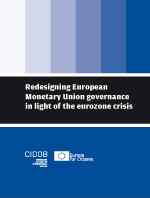Cidob, (2015), “Redesigning European Monetary Union governance in light of the eurozone crisis”, Coleccion Monografias-Barcelona Center for International Affairs, May 2015
When political leaders met at Maastricht in December 1992 and took the historic decision to create the EMU, they were responding to several challenges. First, the gradual liberalisation of capital movements that was necessary to complete Europe’s single market made it increasingly difficult to stabilise exchange rate fluctuations in the context of the European Monetary System (EMS). Second, the weight of the German economy and the credibility of the German central bank meant that the functioning of the EMS was increasingly dominated by German monetary policy. Related to this, significant stress was placed on the EMS by German reunification, which both increased the relative size of the Germany economy and made the adoption of a contractionary policy by the Bundesbank necessary. In light of this, the creation of a European central bank was seen by some as a way to dilute German monetary dominance. Finally, just as European integration was envisaged as a necessary complement to a stronger Germany in the context of the Cold War, German reunification increased the need to move on with the process of economic and political integration across Europe.
Relevant Posts
- Buti, M. & Turrini, A. (2015) “Three waves of convergence. Can Eurozone countries start growing together again?“, VoxEU Organisation, 17 April.
- Corsetti, G., Feld, P. L., Lane, R. P., Reichlin, L., Rey, H., Vayanos, D. & Weder di Mauro, B. (2015) “A New Start for the Eurozone: Dealing with Debt – Monitoring the Eurozone 1“, Centre for Economic Policy Research, 15 April.




